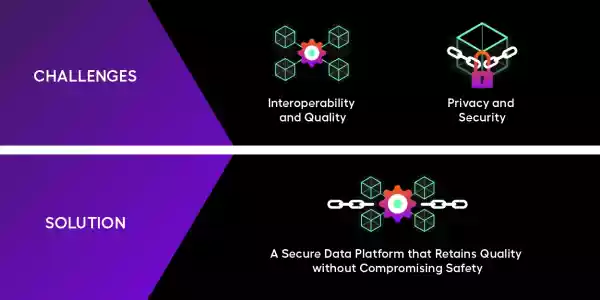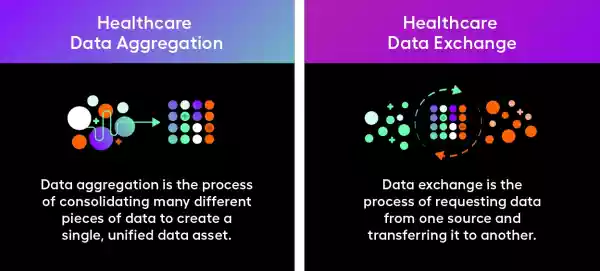Healthcare data aggregation: Key insights for usable data
As the amount of health data produced grows exponentially, healthcare data aggregation has become the necessary foundation for unlocking insights across disparate sources. Aggregation enables comprehensive and accurate data analytics, which drives informed decisions across care delivery, resource allocation, and other workflows.
This article explores key insights about data aggregation for teams across the healthcare landscape, including its impact on value-based care and considerations for implementing it.
What is healthcare data aggregation?
Data aggregation within the healthcare industry involves consolidating many different pieces of data (health information, finances, lab results, etc.) to create a single, unified data asset. With all of this data collected in one place, health leaders can process large amounts of information simultaneously to determine insights, trends, and predictions.
Benefits of healthcare data aggregation
When integrated correctly, data aggregation can have transformative benefits on the healthcare sector as a whole, including:
Increased data reliability and quality. A larger sample size enables organizations to examine the health of one patient in context with the health of thousands. Therefore, providers can make more informed decisions and treatments based on reliable, comparative data.
Reduced administrative burdens. Aggregated data keeps clinical and claims data processing moving at a quicker rate, enabling healthcare organizations to enhance the timeliness and accuracy of care.
Enhanced preventive care. By aggregating current and historical data, physicians can use predictive analytics to forecast future health events. Most importantly, physicians can turn these insights into actions (i.e., if a patient is experiencing “A,” do “B” to get “C” outcome).
Increased trust and transparency. With aggregated data, providers, insurers, patients, and other stakeholders can effectively pursue unified goals.
By centralizing siloed data through aggregation, your organization can take data and transform it from transactional to informative. When completed over time, it can improve health outcomes and reduce costs.
What does data aggregation mean for value-based care?
Aggregation is necessary for data-driven value-based care. It allows an organization to bring all of its data together to surface insights that wouldn’t normally be evident in a single patient chart.
For example, a healthcare organization may be able to uncover the fact that all of their patients who go to a particular specialist are receiving prescriptions for an older, costlier, and less effective drug than those who go to other specialists. If this organization were to evaluate each of those patients individually, the patients would appear to be receiving appropriate care. But when compared to the rest of their peer group, they fare worse than those receiving the newer, less costly, and more effective treatment.
This type of analysis is an integral factor in improving the health of patient populations, and it can only happen if an organization is able to aggregate data. Once aggregated, problem areas can be identified and understood, and the healthcare system can then use that information to make better decisions.
Healthcare data aggregation challenges
Healthcare leaders face two major data aggregation challenges:

Interoperability and quality. Combining data from disparate sources, such as physician notes, electronic health records (EHRs), and diagnostic imaging, often leads to inconsistent formatting, duplicate entries, and other quality issues. Successful data aggregation requires more than simply compiling data — it involves cleaning and organizing data to ensure accurate and complete information.
Privacy and security. Beyond compliance with the Health Insurance Portability and Accountability Act (HIPAA) regulations, protecting patients’ sensitive data is necessary for each individual’s well-being. Considering that the healthcare industry consistently ranks highest in terms of data breaches, aggregation processes must be careful not to expose data to unauthorized access.
The solution to these data aggregation challenges lies in trustworthy integration technology. A secure data platform can retain quality and shareability without compromising privacy, so that health teams can focus on insights instead.
Healthcare data aggregation vs. exchange
Unfortunately, the healthcare industry is full of confusing and often misused terminology. Our latest case: data aggregation and data exchange. These two words have two fundamentally different underlying meanings. Even so, they’re often used interchangeably, leading to industry-wide confusion about which is which and which is more important.
At a high level, aggregation involves bringing many things together, and exchange involves things passing from one entity to another. But beyond their definitions, the best way to differentiate these two terms is by how they are used in practice and their impact on healthcare today.

What is healthcare data exchange?
Healthcare data exchange is a single, transactional experience that involves requesting data from one place, packaging it up, and sending it somewhere else in the healthcare ecosystem.
Electronic health information exchange (HIE), at its very basic definition, allows healthcare providers and patients to appropriately access and securely share a patient’s vital medical information electronically, improving the speed, quality, safety, and efficiency of patient care.
Benefits of healthcare data exchange
When used securely and within a reliable software framework, data exchange can improve care coordination so that primary care physicians, patients, specialists, and hospitals can access and share patient information. This reduces the risk of errors, decreases costs related to duplication or missing data, and safeguards against unnecessary treatments.
At the same time, enhanced data exchange supports improved patient engagement, thus promoting better self-care management. With increased accessibility to portals, patients can begin to take a more active role in studying their medical history, analyzing their test results, and completing their treatment plans.
What does data exchange mean for value-based care?
At its very basic functionality, when done right, data exchange allows physicians to have a more complete medical record, which enables them to better treat that patient. But it’s not as easy as it sounds.
In addition, today’s standards and technical capabilities are still evolving, meaning not every provider has the exchange infrastructure in place to support this transaction.
Data exchange is highly valuable in specific instances, but in many cases, people mistake it for the foundation of what they are trying to do with value-based care: analyze and inform the care of a population.
The full picture: Combining healthcare data aggregation and exchange
Ultimately, healthcare data aggregation and exchange are both important and should be used in tandem to make the best investments and succeed in value-based care. The key is using modern healthcare technologies that can integrate and analyze data from multiple systems to improve care outcomes and drive financial performance.
Arcadia enables data aggregation for providers and health plans by connecting more than 30 different EHRs and combining that with claims and other data to provide a complete picture of patient care. This way, health teams can make informed decisions about the optimal care for a patient population (the cornerstone of value-based care).
Arcadia’s mission is to deploy data in service of healthier lives, and we partner with healthcare providers and payer organizations to empower everyone from the C-suite to the waiting room. From data aggregation to data exchange, let’s unearth insights and accelerate your team’s goals.
